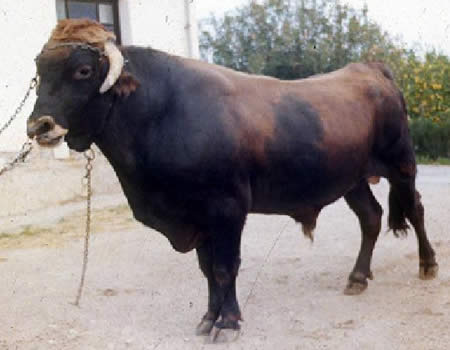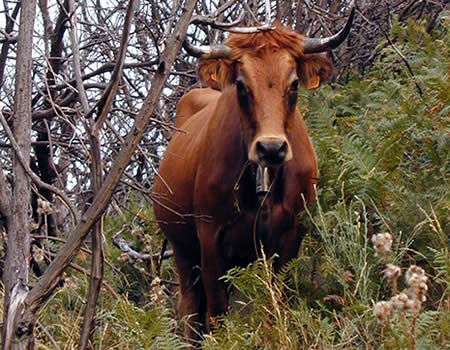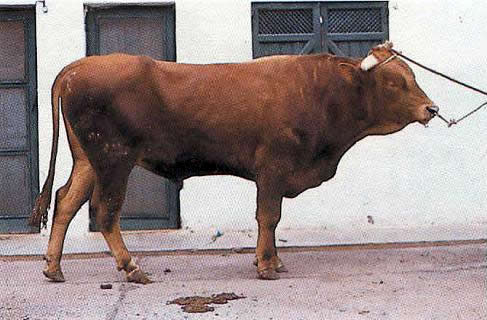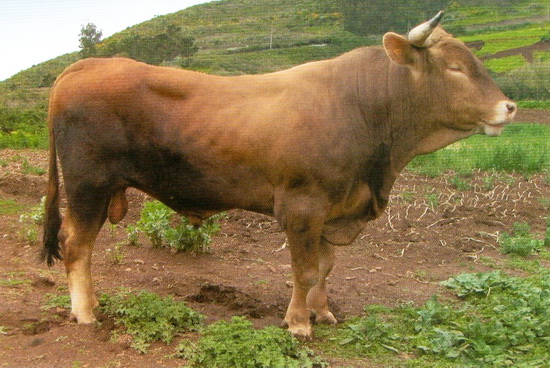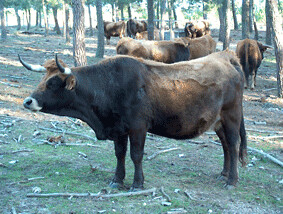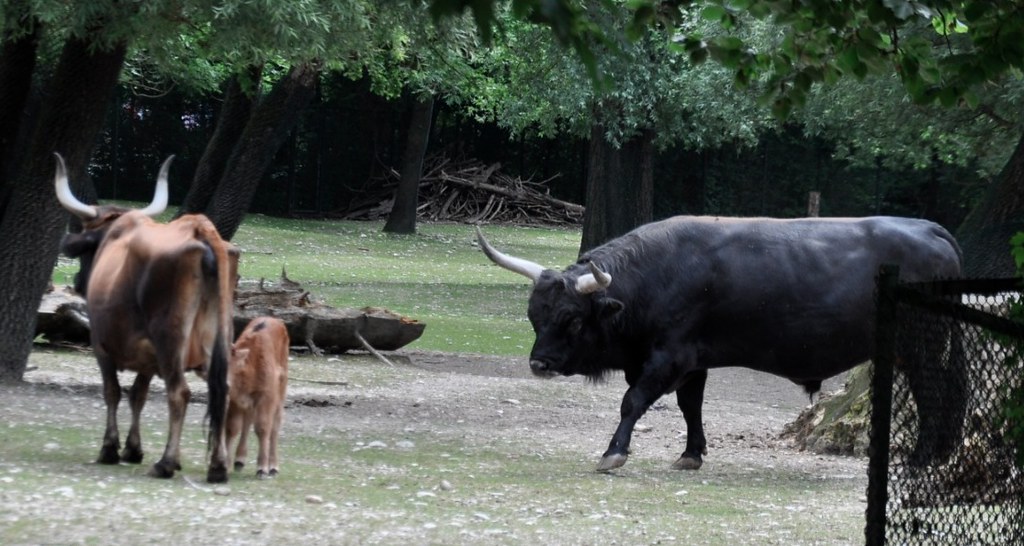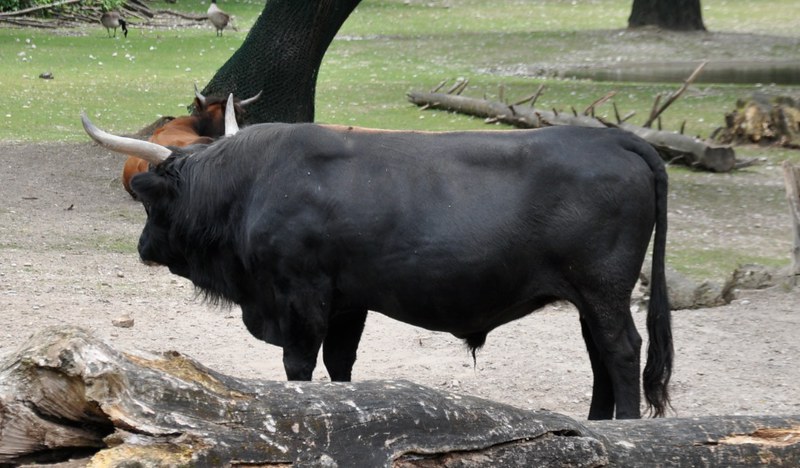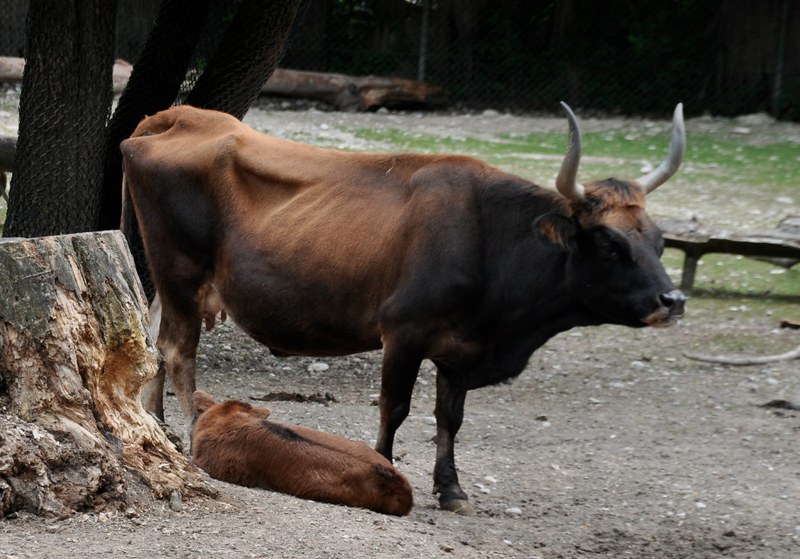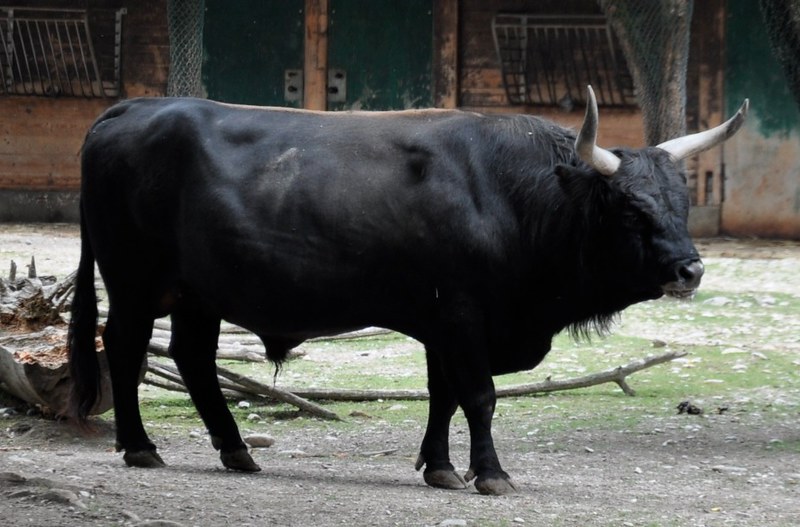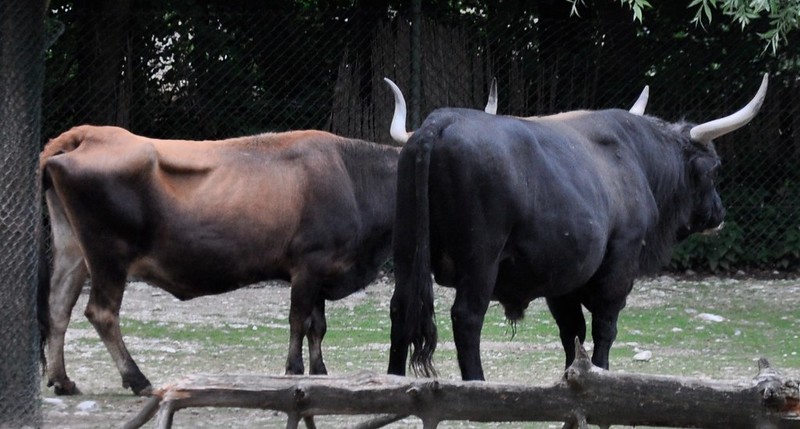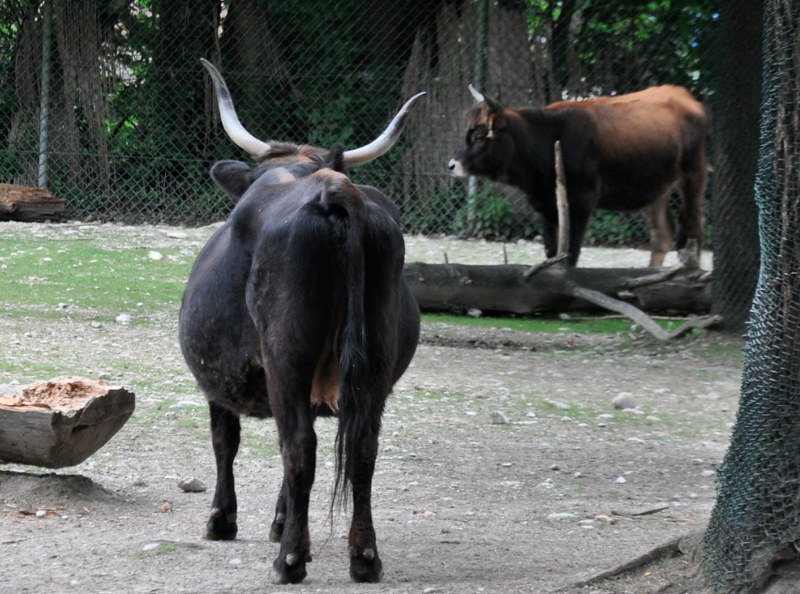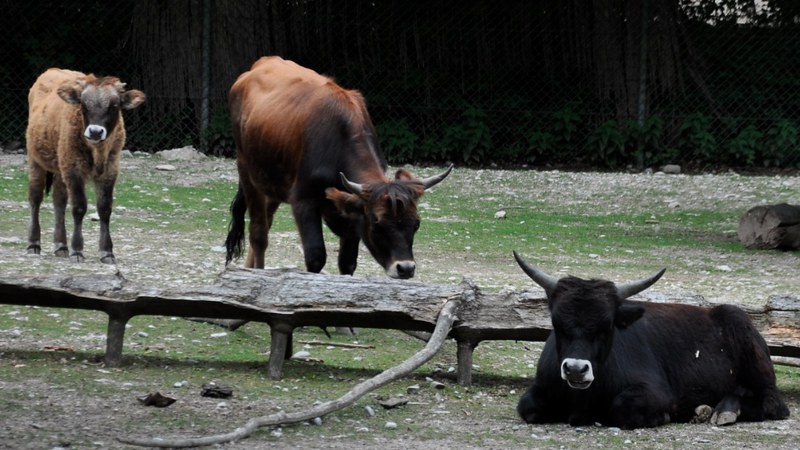Actually, I finished them last week, but this day I finally have the time to post them here. The bull model was sculpted using SuperSculpy firm and FimoSoft (a mix that turned out too soft for me), the cow was done using the former exclusively.
The models are 19 and 17 cm tall respectively, so scale 1:8,94 to a bull that would be 170 cm tall at the withers. The bull is based on the Braunschweig skeleton (no photo online), although I made the horns a little lower (not intentionally). The horn angle is still within the aurochs' range, but on the lower end. The cow is a mix of the Camebridge and Sassenberg specimen. I payed a lot of attention on replicating the proportions exactly by doing a lot of sketches, measuring, and superimposing photos of the models and the actual skeletons.
As you can see, the body of the bull is very muscular and defined, just like it is the case in Lidia and male gaurs (and probably also if you shave a bison). My model probably shows what the body of a middle-aged adult bull would look like, an old bull probably would be a little heavier in build. Of course I sculpted the obligate forelocks between the horns, and also gave the facial and neck area curled hair for reasons I'll point out in a future post. I used the heads of Lidia, Sayaguesa and also Maremmana as a template for what the skulls might look like in flesh, but of course did not digress from what the actual skulls implicate.
The colour of the models is based on the coat colour of the Heck cattle at Hellabrunn, Maronesa, Sayaguesa and aurochs-coloured Lidia. The colour of the horns too, but I also looked at drinking horns that were not severely discoloured.
Here is a size comparison between an 180 cm human and an aurochs of the size of 180, 170 and 160 cm at the withers, using the bull model:
This is my first artwork using polymer clay, and some details of the leg posture or the metapodials are not as refined as I wished them to be, but all in all I am very satisfied with the outcome. Honestly, they look very much like I would imagine living aurochs to look like.
I am thinking about also doing an average Heck bull for comparison, but my next model is going to be a Paraceratherium.
"Breeding-back" aims to restore or immitate extinct animals by selective breeding. This blog provides general information, the facts behind myths and news from various projects.

Saturday, 31 May 2014
Thursday, 29 May 2014
Some other aurochs-like cattle, Pt. III
Here are some more photos of aurochs-like cattle that were not covered much here yet:
Murciana
Serrana negra
Terrena
Vianesa
Murciana
Serrana negra
Terrena
Vianesa
Wednesday, 28 May 2014
Thanks a lot to my readers!
I would like to thank my loyal readers despite the low number of posts during the last month - there was absolutely no drop in view numbers since my "taking a break" post weeks ago, which is awesome. Thanks a lot!
More posts are about to come: more photos of primitive cattle, more on the history of Heck cattle, photos of my finally finished aurochs models (yay!) and other artworks, and a little bit more species diversification - megafauna and extinct animals-related of course.
Stay tuned!
More posts are about to come: more photos of primitive cattle, more on the history of Heck cattle, photos of my finally finished aurochs models (yay!) and other artworks, and a little bit more species diversification - megafauna and extinct animals-related of course.
Stay tuned!
Friday, 23 May 2014
New (?) video of Tauros crossbreeds
Once again from Kempen~Broek, where the Highland-Maremmana cows, a Sayaguesa bull and their offspring live. The video was posted two months ago, but I am not sure if it really is two months old. In any case, you get a good glimpse of the animals, especially the second-generation crosses. Most of the heifers are very dark, and many of them have light mucosa possibly due to dilutions inherited from Highland (they have to be phenotypically E+, since this allele is dominant over e). Unfortunately you don't see much of the the young cross bull on the video. The crossbreeds are too young to get an idea of their horns yet, but I think their shape probably will not be that impressing.
Some other aurochs-like cattle, Pt. II
In the previous entry, I posted some photos of aurochs-like breeds that haven't been covered here greatly yet, and here you have the second part.
Canaria
Limia
Mirandesa
Modicana
Monchina
Canaria
Limia
Mirandesa
Modicana
Monchina
Sunday, 18 May 2014
Some other aurochs-like cattle, Pt. I
There are a lot of aurochs-like cattle breeds in Iberia that haven't got much attention here and that are not in any breeding-back project (up to date) with the exception of Limia, of which I gathered some good photos too. These breeds are not necessarily less primitive than those used in aurochs project, not at all. In the lack of time and information, I cannot write a lot on them here, but I'll link some photos of more or less aurochs-like individuals here (as you know, many of those breeds are variable in appearance).
Alistana-Sanabresa
Avilena
Caldela
Alistana-Sanabresa
Avilena
Caldela
Saturday, 10 May 2014
Video of Lamarck, the Taurus bull
Lamarck is the awesome Taurus bull at Hellinghauser Mersch, Lippeaue, that I saw about one and a half year ago. I think that this bull is the most aurochs-like bull in whole Central Europe - almost all of his features are superb. So I was quite happy when I found this video a few days ago:
EDIT: The video was removed due to negative reactions.
EDIT: The video was removed due to negative reactions.
Wednesday, 7 May 2014
The Hellabrunn herd, a nice herd
I already did a post on this herd, but I feel I did not make appropriate use of the photos I took when I visited it in 2011. As I already said, that herd is the first Heck herd I ever saw, and therefore I like it very much, personally. But this herd is also remarkable for showing an - as much as we can say - 100% perfect aurochs coat colour with a well-marked sexual dichromatism, apart from some black cows. The horns aren't worth mentioning though, and the body is heavy and typical for central European milk-meat breeds, but for me they are nice to look at because of their colour. There are only very few Heck herds with such a good colour, and only few Iberian breeds.
The Hellabrunn herd is an important founding herd of the Wörth lineage, thus they have certain similarities. For example, the adult bull's right horn curves more outwards and upwards than the left, and some individuals from the Wörth lineage show the same asymmetry.
When I visited the herd back in 2011, my idea of the aurochs' outer appearance was not very precise - so I was not really aware of the differences - therefore it really was a magic moment for me to watch these cattle.
Now, enjoy the photos:
It's funny that you can actually recognize the founding breeds looking at certain features in this herd. The fur colour is certainly inherited from Corsicana (although "improved"), the vaguely torpedo-like trunk of the bull you see on the two upper photos is a legacy of that breed as well, otherwise its body and also the skull is very highland-like. The body shape and proportions of the cows, as much as the face of the adult cow, reminds me of Angeln cattle. The horns of this herd definitely resemble those of Hungarian Grey the most, but those of the bulls also look a bit like the horns of some Highlands.
The Hellabrunn herd strikingly resembles some of the historic Heck cattle (only of Heinz Heck's lineage, of course), which is logic from the population genetic sense because this zoo is where Heck cattle originated and where all other Heck herds come from, and therefore necessarily diverged phenotypically because of genetic drift. However, it could be a coincidence as well because genetic drift would effect the Hellabrunn herd as well and they are not the only Heck cattle that resemble the early members of the breed (but note that the Hellabrunn Hecks have features of the original crosses that others usually don't, like the torpedo-like trunk of the bull or the look of the face of the adult cow).
The Hellabrunn herd is an important founding herd of the Wörth lineage, thus they have certain similarities. For example, the adult bull's right horn curves more outwards and upwards than the left, and some individuals from the Wörth lineage show the same asymmetry.
When I visited the herd back in 2011, my idea of the aurochs' outer appearance was not very precise - so I was not really aware of the differences - therefore it really was a magic moment for me to watch these cattle.
Now, enjoy the photos:
It's funny that you can actually recognize the founding breeds looking at certain features in this herd. The fur colour is certainly inherited from Corsicana (although "improved"), the vaguely torpedo-like trunk of the bull you see on the two upper photos is a legacy of that breed as well, otherwise its body and also the skull is very highland-like. The body shape and proportions of the cows, as much as the face of the adult cow, reminds me of Angeln cattle. The horns of this herd definitely resemble those of Hungarian Grey the most, but those of the bulls also look a bit like the horns of some Highlands.
The Hellabrunn herd strikingly resembles some of the historic Heck cattle (only of Heinz Heck's lineage, of course), which is logic from the population genetic sense because this zoo is where Heck cattle originated and where all other Heck herds come from, and therefore necessarily diverged phenotypically because of genetic drift. However, it could be a coincidence as well because genetic drift would effect the Hellabrunn herd as well and they are not the only Heck cattle that resemble the early members of the breed (but note that the Hellabrunn Hecks have features of the original crosses that others usually don't, like the torpedo-like trunk of the bull or the look of the face of the adult cow).
Subscribe to:
Posts (Atom)









